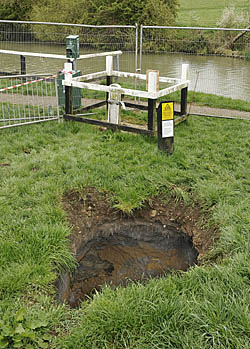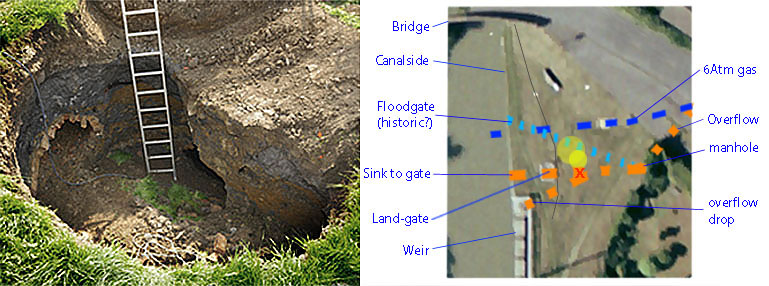|
April 2009 - a mysterious hole appeared
A passerby reported to British Waterways that a hole had appeared in the middle of a grassy triangle of Waterways land adjacent to Candle Bridge, quite near to the canal-side weir. It was immediately fenced off. In the following few days the hole enlarged itself and presented the inset view on 17th April. Water was seen trickling through at a depth of about 8 feet below the turf but the hole appeared to be much deeper than that. The substantial loss of soil, evidenced by the surface collapse, suggests a water path that would have generated a scouring action for quite a time. The obvious suggestion was that one of the culverts at a depth of 16 to 18 feet which collect water from the weir and the land-gate may well have collapsed allowing a path for washed soil to go into the nearby lake and onwards down to Swan Valley. The trickle at a much shallower depth, however, indicated that the land-gate or perhaps its brick box may be damaged too. By 24th April it was obvious to the BW staff that the wooden paddle in the land-gate had rotted to such an extent that it was serving little purpose and, anyway, to provide effective shut-off in times of drought it had been more or less completely filled with ash silt to seal it. In enquiries it was not possible to ascertain the origin of the trickle, being probably a lesser concern anyway. After all, this account is not supposed to serve as an engineering report.
An excavator was used to removed more soil so revealing an old collapsed dry culvert, seen above to the left, that was no doubt used to provide in the old days (before the weir was built in 1958) a means of flooding in emergencies the adjacent field called Pond Bank. The old culvert has been sealed off and is shown in light blue in the mock-up schematic on the right. The pale yellow circle represents the main hole as seen on 25th April and the smaller yellow circle indicates the very deep (12 feet and beyond) hole that is evident by the base of the ladder. Note there is an electric cable running down into this 'abyss' - someone had probably made an inspection. The idea of a breached culvert at roughly where there is a red cross seemed very plausible. The culverts, at a depth of about 18 feet, are shown orange in the schematic. The dark blue line near all this excavation, both natural and human combined, is the high pressure natural gas conduit, 12 inches diameter, which steeply banks downwards to pass under the canal. At that stage it was not thought to be involved in this business. The fine black line passing close to the land-gate is a fibre-optic communications line running from London to Birmingham carrying a vast number of data channels. Luckily it had been only partially uncovered, in its plastic green pipe, at the side of the excavation, far enough out of harm's way. Once the minor leakage had been sorted out the next phase was for a specialist sub-contractor to excavate a massive hole in order to gain safe access to the suspected damaged culvert. This was to take several days and, in the interests of safety, the hole was roughly backfilled with earth whilst the contractors were awaited. PART II ......
|
 PART I 15th April 2009
PART I 15th April 2009